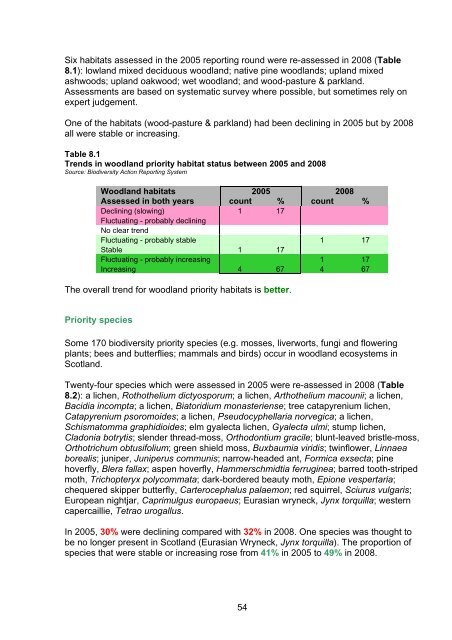Scotland's Wildlife â an assessment of biodiversity in 20
Scotland's Wildlife â an assessment of biodiversity in 20
Scotland's Wildlife â an assessment of biodiversity in 20
You also want an ePaper? Increase the reach of your titles
YUMPU automatically turns print PDFs into web optimized ePapers that Google loves.
Six habitats assessed <strong>in</strong> the <strong>20</strong>05 report<strong>in</strong>g round were re-assessed <strong>in</strong> <strong>20</strong>08 (Table<br />
8.1): lowl<strong>an</strong>d mixed deciduous woodl<strong>an</strong>d; native p<strong>in</strong>e woodl<strong>an</strong>ds; upl<strong>an</strong>d mixed<br />
ashwoods; upl<strong>an</strong>d oakwood; wet woodl<strong>an</strong>d; <strong>an</strong>d wood-pasture & parkl<strong>an</strong>d.<br />
Assessments are based on systematic survey where possible, but sometimes rely on<br />
expert judgement.<br />
One <strong>of</strong> the habitats (wood-pasture & parkl<strong>an</strong>d) had been decl<strong>in</strong><strong>in</strong>g <strong>in</strong> <strong>20</strong>05 but by <strong>20</strong>08<br />
all were stable or <strong>in</strong>creas<strong>in</strong>g.<br />
Table 8.1<br />
Trends <strong>in</strong> woodl<strong>an</strong>d priority habitat status between <strong>20</strong>05 <strong>an</strong>d <strong>20</strong>08<br />
Source: Biodiversity Action Report<strong>in</strong>g System<br />
Woodl<strong>an</strong>d habitats <strong>20</strong>05 <strong>20</strong>08<br />
Assessed <strong>in</strong> both years count % count %<br />
Decl<strong>in</strong><strong>in</strong>g (slow<strong>in</strong>g) 1 17<br />
Fluctuat<strong>in</strong>g - probably decl<strong>in</strong><strong>in</strong>g<br />
No clear trend<br />
Fluctuat<strong>in</strong>g - probably stable 1 17<br />
Stable 1 17<br />
Fluctuat<strong>in</strong>g - probably <strong>in</strong>creas<strong>in</strong>g 1 17<br />
Increas<strong>in</strong>g 4 67 4 67<br />
The overall trend for woodl<strong>an</strong>d priority habitats is better.<br />
Priority species<br />
Some 170 <strong>biodiversity</strong> priority species (e.g. mosses, liverworts, fungi <strong>an</strong>d flower<strong>in</strong>g<br />
pl<strong>an</strong>ts; bees <strong>an</strong>d butterflies; mammals <strong>an</strong>d birds) occur <strong>in</strong> woodl<strong>an</strong>d ecosystems <strong>in</strong><br />
Scotl<strong>an</strong>d.<br />
Twenty-four species which were assessed <strong>in</strong> <strong>20</strong>05 were re-assessed <strong>in</strong> <strong>20</strong>08 (Table<br />
8.2): a lichen, Rothothelium dictyosporum; a lichen, Arthothelium macounii; a lichen,<br />
Bacidia <strong>in</strong>compta; a lichen, Biatoridium monasteriense; tree catapyrenium lichen,<br />
Catapyrenium psoromoides; a lichen, Pseudocyphellaria norvegica; a lichen,<br />
Schismatomma graphidioides; elm gyalecta lichen, Gyalecta ulmi; stump lichen,<br />
Cladonia botrytis; slender thread-moss, Orthodontium gracile; blunt-leaved bristle-moss,<br />
Orthotrichum obtusifolium; green shield moss, Buxbaumia viridis; tw<strong>in</strong>flower, L<strong>in</strong>naea<br />
borealis; juniper, Juniperus communis; narrow-headed <strong>an</strong>t, Formica exsecta; p<strong>in</strong>e<br />
hoverfly, Blera fallax; aspen hoverfly, Hammerschmidtia ferrug<strong>in</strong>ea; barred tooth-striped<br />
moth, Trichopteryx polycommata; dark-bordered beauty moth, Epione vespertaria;<br />
chequered skipper butterfly, Carterocephalus palaemon; red squirrel, Sciurus vulgaris;<br />
Europe<strong>an</strong> nightjar, Caprimulgus europaeus; Eurasi<strong>an</strong> wryneck, Jynx torquilla; western<br />
capercaillie, Tetrao urogallus.<br />
In <strong>20</strong>05, 30% were decl<strong>in</strong><strong>in</strong>g compared with 32% <strong>in</strong> <strong>20</strong>08. One species was thought to<br />
be no longer present <strong>in</strong> Scotl<strong>an</strong>d (Eurasi<strong>an</strong> Wryneck, Jynx torquilla). The proportion <strong>of</strong><br />
species that were stable or <strong>in</strong>creas<strong>in</strong>g rose from 41% <strong>in</strong> <strong>20</strong>05 to 49% <strong>in</strong> <strong>20</strong>08.<br />
54
















